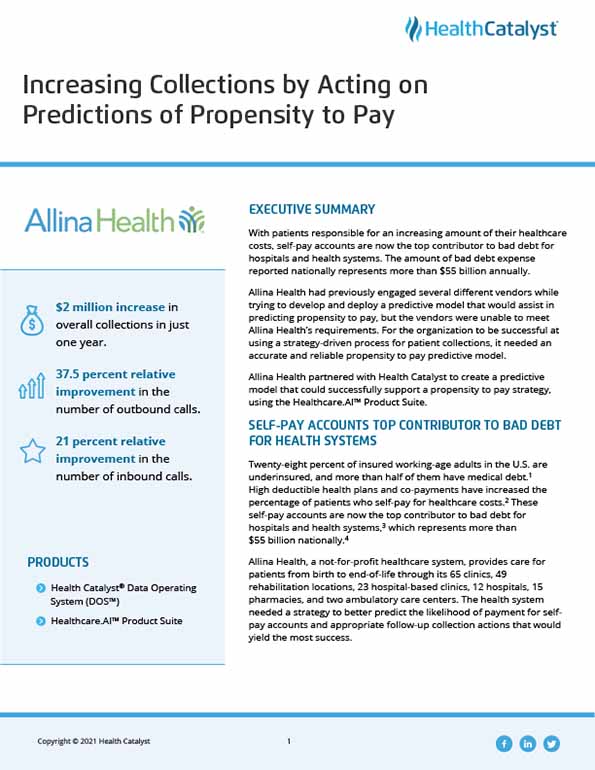As self-pay accounts become a major source of bad debt for hospitals, Allina Health sought a reliable predictive model for assessing patients' propensity to pay. After unsuccessful attempts with various vendors, the organization partnered with Health Catalyst to develop an effective model using the Healthcare.AI™ Product Suite.
With patients responsible for an increasing amount of their healthcare costs, self-pay accounts are now the top contributor to bad debt for hospitals and health systems. The amount of bad debt expense reported nationally represents more than $55 billion annually.
Allina Health had previously engaged several different vendors while trying to develop and deploy a predictive model that would assist in predicting propensity to pay, but the vendors were unable to meet Allina Health’s requirements. For the organization to be successful at using a strategy-driven process for patient collections, it needed an accurate and reliable propensity to pay predictive model.
Allina Health partnered with Health Catalyst to create a predictive model that could successfully support a propensity to pay strategy, using the Healthcare.AI™ Product Suite.
Twenty-eight percent of insured working-age adults in the U.S. are underinsured, and more than half of them have medical debt.1 High deductible health plans and co-payments have increased the percentage of patients who self-pay for healthcare costs.2 These self-pay accounts are now the top contributor to bad debt for hospitals and health systems,3 which represents more than $55 billion nationally.4
Allina Health, a not-for-profit healthcare system, provides care for patients from birth to end-of-life through its 65 clinics, 49 rehabilitation locations, 23 hospital-based clinics, 12 hospitals, 15 pharmacies, and two ambulatory care centers. The health system needed a strategy to better predict the likelihood of payment for self-pay accounts and appropriate follow-up collection actions that would yield the most success.
Allina Health’s financial representatives attempt to collect outstanding balances for 200,000 patients every month. While the organization had good processes in place for contacting patients with outstanding balances, it was not able to target interventions to those people who were more likely to pay their bills.
A focused strategy for the types of accounts and patients they were interacting with would assist, but Allina Health was not able to deploy a predictive model for propensity to pay. Less effective processes, such as cold calls with tailored conversations, were employed as a tactic to collect payments.
Allina Health previously engaged with several different vendors to develop and deploy a predictive model that would allow the health system to use a propensity to pay strategy, but they proved unsuccessful. These companies could not make use of Allina Health’s complex data effectively, interpret the information in a manner that would produce a reliable, valid propensity to pay predictive model.
For Allina Health to be successful at using a strategy-driven process for patient collections, it needed an accurate and reliable propensity to pay predictive model.
Allina Health relies on Health Catalyst® Data Operating System (DOS™) platform for insight supporting its improvement efforts. To build a predictive model that could be successfully deployed to support a propensity to pay strategy, Allina Health partnered with Health Catalyst, selecting its Healthcare.AI™ solution.
The propensity to pay machine learning model uses artificial intelligence to predict the probability that the patient will pay their bill during the month. Allina Health’s data from its analytics platform, including 500,000 training cases, was used in developing the predictive model. Subject matter experts (SMEs) from the organization and Health Catalyst then selected variables for the predictive model based on SME healthcare, financial, and analytical experience.
The random forest’s Gini impurity index algorithm for constructing decision trees was used to determine which variables to incorporate into the final model. Seventy-seven input variables were tested, and forty-six of them were incorporated into the final model. Next, a random forest model was employed to calculate each variables’ relative impact with respect to the probability that a patient will miss their payment. The model performance AUROC, which serves as a measure of accuracy, is good at 0.88 and the AUPR, a measurement of precision and quality is also good at 0.70.
Ensuring this information integrates with current systems, data from the predictive model is exchanged with Allina Health’s EMR and patient statement platform daily, facilitating workflows using an automated dialer, EMR work queues, and patient statement platform. This supports financial representatives in applying the right self-pay collection strategy.
In developing the model for predicting propensity to pay, members of the finance team validated the data, which is then divided into propensity to pay segments, and collection strategies are applied to each one. These propensity segments, and strategies that may be applied, include:
Using the propensity to pay predictive model, Allina Health can also identify patients who have previously received charity care or medical assistance. This enables representatives to send information about charity care to the patient in a timelier manner. Allina Health follows up with these patients using a tailored dialer campaign to ask if they have questions or need assistance.
The propensity to pay machine learning predictive model, in conjunction with Allina Health’s propensity to pay strategy, has allowed the finance team to focus its collection efforts on patients who are more likely to pay. Resources are not allocated to collecting from patients that will either pay their balances without intervention or not pay their bills regardless of interventions. This information allows Allina Health to make the best use of its limited resources, increasing payments for the services provided. Results include:
"Think about the strategy and how you want to segment patient populations. It is better to have more segments and figure out the best way to reach each one. How patients engage predicts how likely they are to pay their bills."
- Barbara Ball, President of Accounts Receivable Services
Allina Health is continuing to improve its propensity to pay strategies and predictive model. The health system plans to send data from the online patient portal vendor back to Health Catalyst to incorporate into the predictive model, enhancing predictions about the patient’s likelihood to engage with Allina Health and pay for the services they received.
1, 3. Ewing, C. (2017). Hospitals seek out new ways to reduce bad debt, focus on self-pay patients. Becker’s Hospital Review.
2. Bradley, P. (2013). 4 steps to utilize a hospital’s own patient data to improve self-pay collections. Becker’s Hospital Review.
4. American Hospital Directory. (2017). Data trends – Bad debt expense benchmarks. HFMA Magazine.




